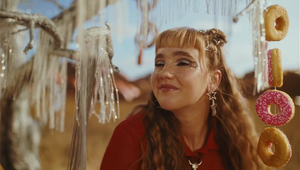
How Lewis Hamilton Journeyed to Find the Perfect Watch

Since 2004, the partnership between watch brand IWC Schaffhausen and automotive company Mercedes AMG has resulted in collaborations allowing both to shine. As the two companies share a passion for performance and design, and a commitment to engineering excellence they have come together in 2023 for another exciting project.
Working together with the Scholz & Friends agency and production company The Sweetspot, the latest collaborative campaign showcases the futuristic feel and forward thinking nature of the watch brand and automotive company, this time partnering with Formula One racer Lewis Hamilton and George Russell.
Working with a computer-generated environment while directing the talent on set, the collaboration was directed by The Sweetspot’s director Sinan Sevinç, with support from executive producer Felix Antretter and post production manager Julia Kastaun. Alongside them, Scholz & Friends’ executive creative director Jörg Waschescio also worked on the project, and together, the entire team tell LBB’s Nisna Mahtani about the process.
“The campaign idea was to set up a joint storytelling between IWC and AMG,” explains director Jörg. “The idea was that we create two campaigns, one by Mercedes AMG (created by agency antoni/ Team X) to celebrate the new GT range, and one by IWC Schaffhausen, which we were responsible for, to celebrate their new Performance Chronographs. Both storytelling angles came together at the Formula One Las Vegas Grand Prix, where they celebrated a joint event.”
Resulting in the creation of ‘Speed City’ (created by agency Amsterdam Berlin), where cars and watches came together in the setting of Las Vegas, each brand showcased its journeys and storylines. Jörg continues, “In the GT cama Lewis and George [Russell] attended a race in the desert, the IWC campaign sets in as they take the road to Vegas, and stop by at the IWC watch shop to gear up with the latest watches for the race.”
Aligned vision in hand, the campaign’s director Sinan explains, “When we started working on the treatments of that we knew that the film lives from a visually driven atmosphere.” It was the combination of two things - “the Las Vegas ‘70s retro charm on the outside of the watch shop and then on the inside, that minimalistic futuristic world with the modern interior.” A vision that provides both contrast and cohesion between the products.

He continues, “To get that result that we wanted, we did a lot of pre-visualisation with the art department without the DP shout-out to Christopher Behrmann and also Christina Mammes from the art department did a great job.” The team worked hard to underline the overall mood and get everyone on the same page, so that the CG elements, holograph and aesthetic were aligned throughout the process.
Sinan shares the line of the brief which resonated with him,
“It's a typical vintage diner. But instead of delivering fries and burgers, you get the new watches from IWC.”
From the production side of things, The Sweetspot’s Felix explains, “From the beginning, we knew that we had to create this diner, we had, we knew that we had to shoot in Barcelona or Madrid and that we had to do it in a certain budget and time frame.” The team were keen to shoot and then create and modify on top of that, to achieve exactly what they wanted in the VFX process.
Julia further explains, “It was a very, very, very traditional process for the VFX department. For the diner, we spoke with an artist who has a background in architecture, and we would literally draw on paper the vision Jörg and Sinan had together. It wasn’t days, it was weeks because we would approve things and then jump into the digital world.”

They were trying to get rid of that ‘uncanny’ feeling that can come out of the CG process to make things look more organic, and real. Julia says, “We were figuring out how to organise the chaos. For example, how do we organise the sand, which comes from the desert onto the street? How do we make it look natural?” As they say, the devil is in the details and that’s what the team was keen to get right.
What made it even more high stakes is the fact that the IWC’s CEO Christoph Grainger-Herr is an architect himself, meaning that there was a clear vision for structures such as the diner. Jörg explains, “There's a professional judging the architecture, not just the normal client who's looking at if it looks good or not.”
Speaking of the location itself and the intricacies of shooting, the set was of a small scale, but had to mimic the grandeur of a larger location. This meant that infusing light from out-of-camera sources wasn’t an option, so the result was the lighting department creating a glowing wall behind the counter. Sinan explains, “We had all the lighting within the set, ready for when we needed little bounces of lights for close-ups, perfectly designed to shoot all the assets we wanted.”
Having this ready whenever they needed specific lighting for shots meant that the team were able to utilise the limited time that they had with the talent on set. “Every minute was very very well prepared,” says Felix. “We had a photoshoot in the next room, a social media team to create content and were rotating non-stop.” The crew also created multiple endings for the several films they shot, so that they were able to change things during the editing process if needed.

This was all coordinated during the pre-shoot where the lighting, details and initial shots were conducted to ensure everything ran smoothly on the day. After the content was all captured, a director’s cut was produced, but the team were fluid with adapting to the client. “We had different options for different products we had to show, different colours of the watch, but always within the cosmos of what we wanted to achieve,” says Felix.
Additionally, as Jörg explains that CG work was also required to let the watches shine in the best light. “A lot of what is in the film is CG enhanced, and we had to bring a watch experienced post guys to help craft that.”
To keep things as seamless in the post process as possible, Julia explains, “You have to be absolutely professional to get the things that we shot done in that small of a timeframe. We produced up to nine movies between seven and 15 seconds, and several snippets up to 10 seconds. That gives you some insight into how much we had to shoot!”
Sinan jokes, “I think on the next project, it’s worth trying for the world record of assets shot in one day! But, we had a great team to get that number.”
Together, the entire team, including the photographer Max Baya and everyone else on set, had the advantage of having worked together previously and in turn, understanding how to best utilise the skills on set. With a complex schedule on the day of shooting, the team explained how everyone was able to pull their weight to achieve the final result and support this latest collaboration between IWC Schaffhausen and Mercedes AMG.















